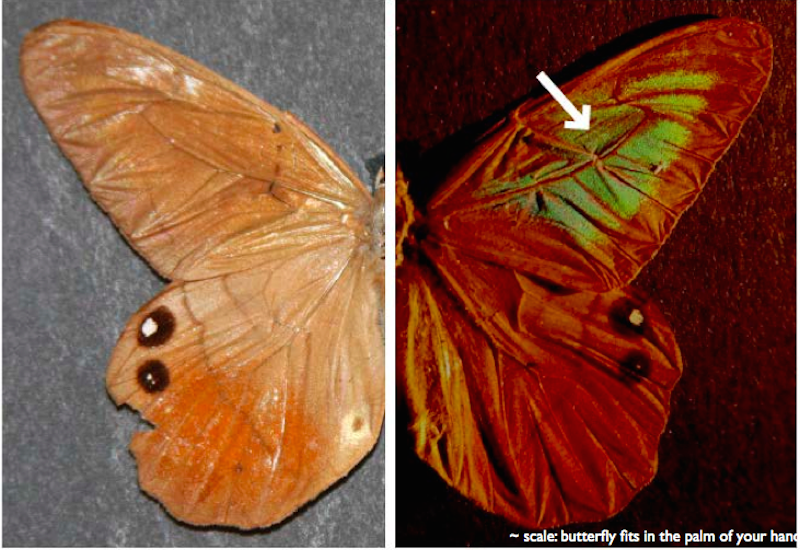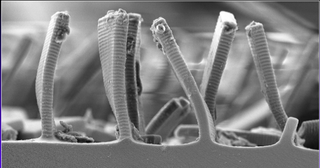Colorful Butterfly Wings Inspire Counterfeit-Proof Tech

To stop identity thieves and counterfeiters, a group of researchers is looking for inspiration from an unlikely source: butterflies.
In order to attract a mate, the male Pierella luna butterfly of Latin America uses its wingsto perform an advanced optical trick known as reverse color diffraction. Thanks to the microstructure of its wings — made up of tiny scales curled slightly upward at the end to diffract light — the butterfly appears to change color when it's viewed from different angles.
Now, researchers at Harvard University have figured out a way to use artificial photonic materials to mimic the Pierella luna's attractive light show. They've created what's known as a diffraction grating, a surface that splits white light into its individual wavelengths of color and sends those colors traveling in different directions. When the photonic material is viewed from one angle, it looks to be one color, but from a different angle, the color appears to change, according to study co-author Mathias Kolle, a member of the Harvard research team and an assistant professor of mechanical engineering at the Massachusetts Institute of Technology (MIT). [Butterfly Gallery: Beautiful Wings Take Flight]
If you've ever owned a CD, then you've probably witnessed normal color diffraction in action, Kolle told Live Science. Imagine putting a CD shiny side up on a table and then shining a light on it. Different colors appear on the CD's shimmery surface, depending on how you move your head.
This happens because the tiny data tracks that make it possible for you to listen to the CD also serve as a diffraction grating, splitting white light into its different wavelengths of color.
But this optical trick is more than just something to stare at; it can also be put to good use, the researchers said.
"We thought there could be some benefit for such a unique [material] in security printing," Kolle said. "Or, potentially, we could tailor the output of light-emitting devices by putting such a structure on top of them. The material could also coat the solar panels, to manipulate how light enters the individual cells, he added.
Sign up for the Live Science daily newsletter now
Get the world’s most fascinating discoveries delivered straight to your inbox.
It's the new photonic material's microstructure that could make it valuable for a range of applications. The superthin, transparent material consists of an array of microscopic plates, or scales, that mimic those that make up the Pierella luna's wing. Each plate is about 18 micrometers tall — about one-fifth the diameter of a human hair — and each features a scalloped, or ridged, edge. The ridges on each plate look like tiny lines running through the material and are spaced about 500 nanometers apart.

"It's like if you take a notebook and put it on its side standing up, and then you put many notebooks the same distance from each other. That's the fundamental structure," Kolle said.
All of these features — both the plates themselves and the ridges running through them — can be manipulated to create different optical effects, Kolle said. By changing the height size and spacing between the plates or the ridges, the researchers can change how the material diffracts light — a feature that Kolle calls "tunability."
The material is also fairly difficult to recreate, Kolle said, which is why he thinks it could be used to make more secure banknotes or passports. If used for such purposes, it would lend these printed objects a so-called "optical signature," he said.
The ability to tune the material to specific wavelengths could also make it valuable for producers of solar cells or light-emitting diodes (LEDs) used inside consumer electronic devices. Both of these products need to be as efficient as possible in the ways they absorb or release light, the researchers said.
"We're also hoping we can tailor these structures to increase the coupling efficiency of light into a solar cell. And it's the inverse problem with light-emitting devices: Light has to come out of the LED, and we think that we can improve the out-coupling efficiencies from LEDs," Kolle said. Increasing coupling efficiency means that light enters a solar cell or exits a LED in a more precise way, resulting in a stronger and longer lasting optical signal, he added.
The study was published online today (Oct. 6) in the journal Proceedings of the National Academy of Sciences.
Follow Elizabeth Palermo @techEpalermo. Follow Live Science @livescience, Facebook & Google+. Original article on Live Science.

Elizabeth is a former Live Science associate editor and current director of audience development at the Chamber of Commerce. She graduated with a bachelor of arts degree from George Washington University. Elizabeth has traveled throughout the Americas, studying political systems and indigenous cultures and teaching English to students of all ages.










